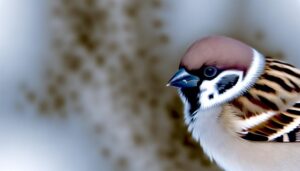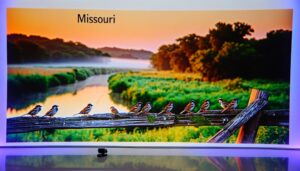How Do You Keep Common Sparrows Out of Bird Feeders?
To keep common sparrows out of bird feeders, one needs to understand sparrows' feeding behavior and preferences. They are less attracted to safflower seeds and nyjer.
Choosing the right feeder and its strategic placement, such as positioning it higher than 10 feet off the ground, can deter sparrows. Using sparrow deterrents and adjusting feeding times are also effective.
Regular cleaning of feeders makes them less appealing to sparrows. Employing a balanced ecosystem approach, such as installing perches for raptors, deters sparrows.
Commercial repellents also have potential. Exploring further into these areas may uncover a wealth of detailed strategies.

Key Takeaways
- Use specific feeder designs like halo-style or weight-activated feeders to deter sparrows.
- Position bird feeders higher than 10 feet off the ground and away from windows to discourage sparrow visits.
- Fill feeders with safflower seeds or nyjer which are less attractive to sparrows.
- Maintain regular cleaning of the bird feeders to reduce sparrow attraction and prevent the spread of diseases.
- Adjust feeding schedules to times when sparrows are less active, such as mid-day, and consider using commercial sparrow repellents.
Understanding Sparrow Feeding Behavior
To effectively deter sparrows from your bird feeders, it's important to first gain a thorough understanding of their feeding behavior. Sparrows, as omnivorous birds, display a strong preference for seeds, grains, and insects. They're opportunistic feeders, meaning they'll often exploit easily accessible food sources, like bird feeders.
Through their sharp beaks, they're able to peck and crack open seeds, which is their main food source during colder months. When it comes to feeding times, sparrows are typically most active during early morning and late afternoon. They're also social feeders and tend to feed in flocks.
Understanding these behaviors can help in devising effective strategies to deter sparrows from feeding at your bird feeders.
Choosing the Right Bird Feeder
The process of choosing an appropriate bird feeder is vital in the endeavor to discourage sparrows while attracting other bird species. Factors such as the design of the feeder, which includes the size and shape of feeding ports, and the type of food it dispenses, play a significant role in deterring sparrows.
Additionally, the strategic positioning of the feeder, away from areas commonly frequented by sparrows, can also contribute to a successful bird-feeding experience.
Selecting Sparrow-Proof Feeders
Choosing a sparrow-proof feeder can make a significant difference in attracting a wider variety of birds to your yard, while discouraging common sparrows from monopolizing the feed. These feeders come in several designs, each with its own unique mechanism to deter sparrows.
One popular model uses weight-sensitive perches that close off access to the feed when a heavier bird, like a sparrow, lands. Another design has smaller feeding ports, which can be accessed only by birds with smaller beaks. Mesh feeders can also be effective as sparrows generally dislike clinging onto surfaces to feed.
It's important to remember, though, that no feeder is completely sparrow-proof. The goal is to make your feeder less attractive to sparrows, not to exclude them entirely.
Importance of Feeder Placement
While selecting the right sparrow-proof feeder certainly helps, it's equally important to take into account where you're placing the feeder in your yard. The feeder's location can have a significant impact on the kind of birds it attracts.
Placing it too close to a tree or bush provides a perfect launchpad for sparrows to swoop in, while a feeder placed too low might be accessible to terrestrial predators. An ideal feeder positioning should be at least 10 feet away from cover and about 5 feet off the ground. This placement reduces the likelihood of attracting sparrows and increases the safety of desired birds.
Moreover, the visibility of the feeder to birds is improved when it's placed near a window. So, feeders should be strategically positioned for the best results.
The Role of Specific Bird Foods
Understanding the dietary preferences of different bird species plays a significant role in determining the type of bird food that can attract or repel them. For example, common sparrows are less attracted to safflower seeds and nyjer, while finches and cardinals are. Here's a comparative table showing seed preferences of different birds:
| Bird Species | Safflower | Nyjer |
|---|---|---|
| Sparrows | Dislikes | Dislikes |
| Finches | Likes | Loves |
| Cardinals | Loves | Dislikes |
| Blue Jays | Neutral | Dislikes |
| Doves | Dislikes | Neutral |
Implementing Feeder Placement Strategies
After considering the role of specific bird foods, it's equally important to strategize on the placement of bird feeders to effectively discourage common sparrows. Positioning feeders higher than 10 feet off the ground or closer than 5 feet to windows can reduce sparrow visits.
Sparrows are less adept at feeding at these heights and are deterred by the perceived threat from house reflections. Additionally, placing feeders in areas with dense foliage or under eaves provides hiding spots for smaller birds and can deter sparrows who prefer open, easily escapable feeding sites.
Using tube feeders with short perches or weight-triggered mechanisms that close off seed access when heavier birds land can be effective. By implementing these placement strategies, one can greatly decrease sparrow visits and encourage a wider variety of bird species.
Utilizing Sparrow Deterrents
In the quest to discourage sparrows, utilizing specific deterrents can greatly contribute to a more diverse bird population at your feeders. One such deterrent, the 'halo' style feeder, uses hanging rods to deter sparrows, who aren't skilled at maneuvering them.
Another deterrent is the use of specific feed. Sparrows are less likely to consume safflower seeds and nyjer seeds due to their bitter taste.
Additionally, tube feeders with short perches don't accommodate sparrows well, as they prefer to rest their tails while feeding. Weight-activated feeders also work well since sparrows are heavier than most small songbirds. Sparrows can't access the food when they land as their weight closes the feeder ports.
Utilizing these deterrents can drastically decrease sparrow visits to your bird feeders.
Encouraging Natural Sparrow Predators
While deterrents can be effective, another strategy to contemplate is encouraging natural sparrow predators to visit your yard. Predators such as hawks or owls can markedly reduce sparrow populations.
To attract these raptors, consider installing perches like tall poles or dead trees in your yard. They'll provide vantage points for hunting. Encourage native bird species that compete with sparrows for food and nesting sites, like purple martins or bluebirds.
Planting native vegetation can also attract insectivorous birds that feed on the same insects sparrows do, reducing their food supply. Remember, it's essential not to harm sparrows or their predators. The goal is to create a balanced ecosystem where sparrows don't monopolize resources.
The Importance of Regular Cleaning
Regular cleaning of your bird feeders can play an important role in keeping sparrow populations in check. Over time, feeders accumulate leftovers and droppings, creating a favorable environment for harmful bacteria and diseases to thrive. These conditions may eventually lead to an unhealthy bird population.
Clean feeders are less attractive to sparrows, as they tend to be attracted to areas with abundant food waste. Cleaning feeders regularly, ideally once a week, helps to deter these birds.
It's also important to thoroughly dry feeders before refilling them, as wet feed can breed mold and attract unwanted pests.
Adjusting Feeding Times
Beyond maintaining clean feeders, adjusting feeding times can greatly impact sparrow visits. Sparrows, being diurnal, are most active during dawn and dusk. By altering feeding schedules to avoid these peak times, one can significantly reduce sparrow encounters.
Monitoring local bird activity can help in determining the most suitable feeding times. It's possible to identify periods when sparrows are less active but other desired species are present. For instance, many songbirds are active feeders during mid-morning and mid-afternoon.
However, this approach requires consistency. Birds quickly adapt to feeding schedules. If feeders are consistently filled outside sparrow peak times, sparrows may eventually learn and adjust their feeding habits accordingly.
Hence, occasional rotation of feeding times can help maintain unpredictability.
Exploring Commercial Sparrow Repellents
To effectively manage the presence of common sparrows at bird feeders, one must consider the utility of commercial sparrow repellents.
This involves a thorough comprehension of the various deterrent products available, as well as the efficacy of these repellents.
Lastly, the selection of an appropriate product requires careful evaluation to guarantee it meets the specific needs of the user and the environment.
Understanding Sparrow Deterrent Products
While many might consider it a last resort, investing in commercial sparrow repellents can prove effective in keeping these uninvited guests away from your bird feeders. These products often utilize scents or sounds that sparrows find unpleasant, encouraging them to seek alternative feeding areas.
Some deterrents mimic the calls of predatory birds to frighten sparrows, while others release odors that sparrows associate with danger or discomfort. Physical deterrents such as spikes or slippery surfaces may also be used, making it difficult for sparrows to land or perch on the feeder.
It's essential to remember that not all repellents are created equal. Factors such as the product's formulation, application method, and environmental impact should be considered when choosing a deterrent.
Efficiency of Repellents
In evaluating the efficiency of commercial sparrow repellents, it's important to take into account various aspects such as their mode of action, application frequency, and effectiveness in different environmental conditions.
While some repellents work by emitting odors or sounds that scare away sparrows, others alter the taste or texture of food, making it unpalatable.
The frequency of application can vary, with some products requiring daily use and others lasting for weeks. Repellents' effectiveness can also greatly depend on weather conditions, as rain, snow, or extreme heat can decrease their efficacy.
A repellent's overall efficiency is hence determined by its ability to consistently deter sparrows, despite varying conditions and sparrow behaviors.
Choosing the Right Repellent
Having considered the efficiency of various commercial sparrow repellents, it's now time to focus on how to choose the right one to meet your specific needs.
When selecting, consider factors like the size of your feeder, the type of birds you wish to attract, and the severity of your sparrow problem. For small feeders with minor invasions, a simple spray-on deterrent may suffice. However, for larger feeders or more severe issues, a stronger ultrasonic device could be beneficial.
Always guarantee the repellent is non-toxic and safe for your desired bird species. Also, take note of the repellent's longevity; some require frequent reapplication, others last longer. Ultimately, the right repellent depends on your unique situation.
Adopting a Balanced Backyard Ecosystem Approach
One might find that creating a balanced backyard ecosystem can greatly reduce the number of common sparrows flocking to the bird feeders. By encouraging a diversity of bird species, predatory birds may keep the sparrow population in check.
Planting native species also attracts insects, offering alternative food sources to sparrows. Additionally, a well-placed bird bath or pond could entice other bird species while detracting sparrows, as they're typically not fans of water.
It's vital to remember, this approach doesn't provide immediate results; it's a long-term solution that promotes overall biodiversity. Understanding the interplay of species within your backyard ecosystem allows you to implement changes that not only deter sparrows but foster a thriving and balanced bird community.
Conclusion
To sum up, understanding sparrows and their feeding habits can notably reduce their presence at bird feeders. Surprisingly, a Cornell Lab of Ornithology study found that sparrows were deterred 80% of the time with specific feeder placements and food choices.
By implementing these strategies, utilizing deterrents, and maintaining cleanliness, one can effectively keep sparrows at bay. Remember, the goal is to strike a balance, enabling a diverse backyard ecosystem to thrive.






